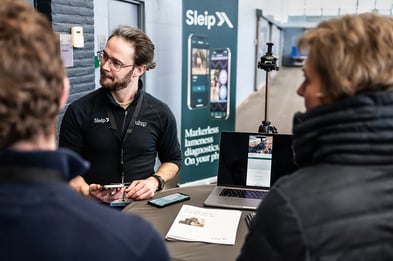Courses on objective gait analysis
Mastering objective gait analysis with leading equine biomechanics experts – Marie Rhodin and Emma Emma Persson-Sjödin

Lameness in horses is a big problem. To help the animals, veterinarian and researcher Elin Hernlund, and her colleague have launched an app that, with the help of AI, can analyze the horses' movements directly on the phone.
Translated summary of article:
When Elin Hernlund, assistant university lecturer in veterinary medicine at SLU, received a research grant to learn more about AI, she came up with the idea of an app that can analyze the horse's movements. This eventually led to her and AI-developer Axel Nyström forming the company Sleip AI in early 2020.
- Lameness is the biggest problem and hugely costly for animal owners and insurance companies. 50 percent of all insurance cases relate to lameness. It is a big cost and a big problem for animal welfare. We need to get a bigger handle on this and do it in time. I hope that Sleip will be very important there, says Elin Hernlund.
Someone who uses the app is veterinarian Maria Terese Engell.
- It is very simple and takes very little time compared to connecting sensors to the horse. It will be an objective assessment of your own perception. The app raises my skills a level and means I do a better job, says Maria Terese Engell, who is a researcher and veterinarian and runs a horse clinic in Finnskogen in Norway. She has been using the app for just over six months.
The tool is really needed according to Maria Terese Engell. She believes that veterinarians can often make mistakes for several reasons, including because humans have difficulty seeing where the lameness is when the horse trots. It simply goes too fast.
- Research shows that we make far too many mistakes. We often take the wrong leg, investigate and treat the wrong leg. From the welfare aspect, it is problematic. We need someone to double check.
The app also makes her ask herself more critical questions and in this way the examination becomes more thorough according to her. Another thing that makes the work easier is that the videos of the horses are saved in the app. So for a return visit several months later, she can go in and see what the horse looked like the last time she saw it instead of just reading the journal.
However, Maria Terese Engell does not believe that such tools will completely take over the veterinarian's role. Rather, she believes that the veterinary profession may become even more important in the future when digital tools are on the rise.
- I was critical for many years. Maybe a little afraid that the vet wouldn't be important, but you become all the more important. This is the way forward. If you are not on board, horse owners will push you forward. Owners will want you to have objective tools so either you are along for the ride or you are not.
In the future, she sees several improvements to the app that can be made and potential areas for this type of digital motion analysis on horses. For example, when horses are bought and sold but also at competitions. That the competition vet can use the technique and lean on it if there is a horse that should not be allowed to start due to lameness. But she also believes in analysing the rider in the future.
- We are not there yet. The rider has a positive and negative impact on lameness. If you can analyse the rider, you can see if it is the cause of the lameness. When it comes to riding horses, riders can have a big impact and technology can help the vet understand that interaction.

Mastering objective gait analysis with leading equine biomechanics experts – Marie Rhodin and Emma Emma Persson-Sjödin

Sleip will continue its sponsorship of the EGAS Live Course 2026 — marking our 4 year supporting advanced post-graduate education in quantitative gait analysis for equine veterinarians.

SLU, Sleip, and a number of private equine clinics have collaborated on a study showing how anatomical size-scaling helps align objective gait data with visual lameness assessments